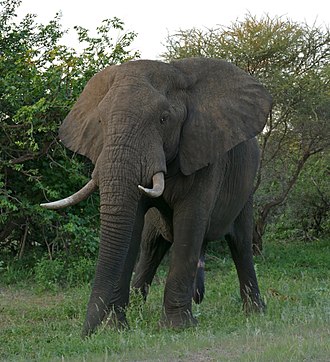African elephants (Loxodonta) are a genus comprising two living elephant species, the African bush elephant (L. africana) and the smaller African forest elephant (L. cyclotis). Both are social herbivores with grey skin, but differ in the size and colour of their tusks and in the shape and size of their ears and skulls.
The first scientific description of the African elephant was written in 1797 by Johann Friedrich Blumenbach, who proposed the scientific name Elephas africanus. Loxodonte was proposed as a generic name for the African elephant by Frédéric Cuvier in 1825. This name refers to the lozenge-shaped enamel of the molar teeth, which differs significantly from the rounded shape of the Asian elephant's molar enamel. An anonymous author used the Latinized spelling Loxodonta in 1827. Anonymous was recognized as authority by the International Code of Zoological Nomenclature in 1999.
Elephas (Loxodonta) cyclotis was proposed by Paul Matschie in 1900, who described three African elephant zoological specimens from Cameroon whose skulls differed in shape from elephant skulls collected elsewhere in Africa. In 1936, Glover Morrill Allen considered this elephant to be a distinct species and called it 'forest elephant'; later authors considered it to be a subspecies. Morphological and genetic analyses provided evidence for species-level differences between the African bush elephant and the African forest elephant.
Between the late 18th and 20th centuries, the following extinct African elephants were described on the basis of fossil remains:
Analysis of nuclear DNA sequences indicates that the genetic divergence between African bush and forest elephants dates 2.6 – 5.6 million years ago. The divergence between the Asian elephant and the woolly mammoths is estimated 2.5 – 5.4 million years ago, which strongly supports their status as distinct species. The African forest elephant was found to have a high degree of genetic diversity, perhaps reflecting periodic fragmentation of their habitat during the climatic changes in the Pleistocene.
Gene flow between the two African elephant species was examined at 21 locations. The analysis revealed that several African bush elephants carried mitochondrial DNA of African forest elephants, indicating they hybridised in the savanna-forest transition zone in ancient times.
Sequence analysis of DNA from fossils of the extinct Eurasian Palaeoloxodon antiquus shows it to be much closer related to the African forest elephant than to the African bush elephant. The validity of Palaeoloxodon has therefore been questioned.
